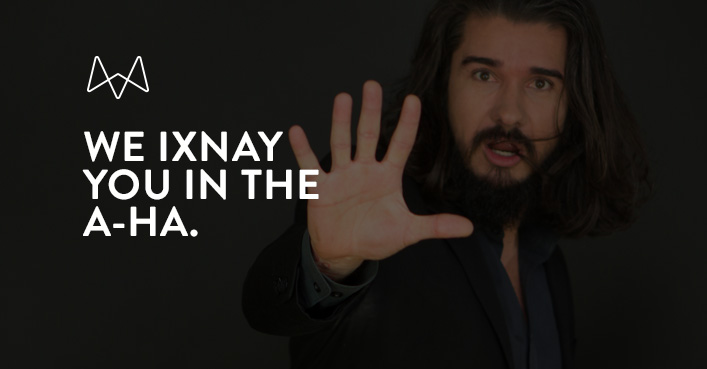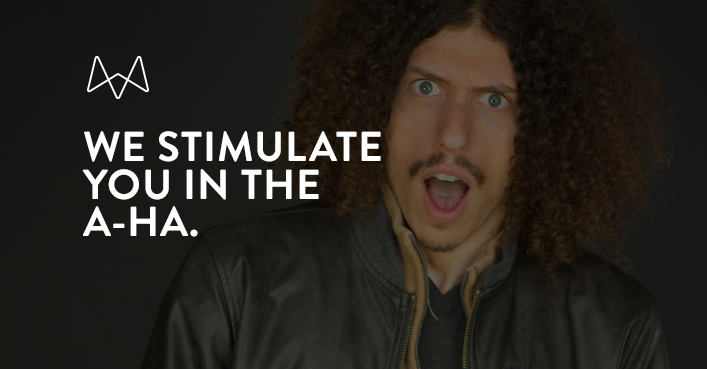In honor of AIDS Is Not A Crime Awareness Day on February 28, we thought we might share the Manifesto we developed during our rebranding of the SF Aids Foundation.
|
Category: Mortar’s Work
September 16th, 2019
Sorry, not sorry, Sarah Connor. Mortar is rocking AI.The launch of Varian’s Ethos ™ therapy today marks Mortar’s fifth foray into machine intelligence* this year. We kicked off 2019 with Cloudability and machine learning (ML) in the cloud. Apptio snatched up Cloudability earlier this year. We featured ExtraHop’s use of ML to stop threats outside the corporate firewall in their 2019 campaign. (See the Rise Above the Noise video here). Our friends at global hearing aid giant Phonak (the parent of Mortar’s client Advanced Bionics) built AI into their new Marvel hearing aids, delighting the hard-of-hearing (the sound from the new devices is apparently incredible!) and resulting in a massive spike in earnings (and, of course, exciting implications for Cochlear Implant recipients—but we can’t talk about that yet. More on that in a future post). Our most recent project, e-commerce disruptor CommerceIQ is built around using AI to unify Advertising and Sales on Amazon.com. Of Sunday’s launch of Ethos ™ therapy, Varian said their innovation “marks the moment when artificial intelligence and adaptive therapy combine to create the world’s first application of Adaptive Intelligence”. Varian goes on to say their breakthrough will “inspire healthcare professionals worldwide to reimagine cancer care”. It’s not quite the mean, machine-driven apocalypse that James Cameron presented in Terminator. But hey, there’s still time. From the cloud to advanced hearing loss to empty shopping carts, and eliminating cancer, we’re hoping machine intelligence can continue to make our lives easier and yes, maybe, curb suffering. Wanna be a part of it? We’re hiring. * At Mortar Machine Intelligence means the various flavors of machine learning (ML) and artificial intelligence (AI). And yes, dear readers, although we know that you know that we know there is a difference between the two, confusion about the difference is undeniably rampant.
August 12th, 2018
Why No is the very last word in Marketing
Oh sure, we’ve read the books about the power of saying no. Saying No is the key to success in any management role. Which would be fine if it wasn’t so darn tough. Marketing is hard enough without trampling on the feelings of our colleagues. And to be so definitive about innovation, well is that really ever wise? So I tell my team that No should be reserved for the absolute last resort. Clients come to us for a way forward, and an energetic and passionate commitment to making the best of what’s been done. But for those of us who still struggle with the two letter negative, here’s five ways to navigate the No conversation: Search for information: before you close off any avenue of inquiry are you sure you have gathered all the relevant data? There are two forms of data available to every marketer: facts and emotions. Just because the company has not done something before does not mean it will not try something new. And just because the last team failed does not mean you can’t organize the data to energize a new round of experimentation and creation. How fixed is the situation? You can think of any marketing conversation as a kind of negotiation. And great negotiators caution us to avoid getting stuck on any point and constantly expand the conversation in search of variables that can be used to move participants past fixed points. What does next week mean? Monday or Friday? Do we really need a product name to develop an elevator speech? Can we make that decisions after we test the idea? Beware of rolling out a no before you have considered all the angles at play. What do prospects have to say? Innovators, by their very nature, must learn to discount criticism and customer feedback: When Henry Ford asked his customers what they wanted, they said a faster horse (he didn’t, but still innovators say this with depressing frequency). The first lesson of Moore’s famous Market Adoption (Chasm) theory is that members of the early market are few and far between and don’t conform to the patterns of the majority. Innovators lean hard on the experience of the early market to identify opportunities. But they also learn not to listen to most people. Nevertheless, many marketing logjam can be cleared with a small dose of feedback from early customers. What about rivals? Many a marketer plans with faulty assumptions about the competition. It rarely makes sense to assume rivals will not match an innovation or worse, are not thinking along similar lines as your team. One of the first principles of Sun Tsu’s Art of War is keep your enemy close, by which he meant understand how your rival thinks. Still, I am often surprised by how reluctant my clients are to model the reaction of rivals. A favored technique is to ask client teams to imagine they are their rivals and attack their plans from that perspective. It is a rare team that does not learn from open and clear contemplation of competitive threat. When there is no way out of No, ask us. Well this may be an awesome time to roll out the agency. Third parties can often say No in a way that internal teams will support. Indeed, one of the great advantages of a smart agency is its ability to Marshall what it knows about a project to drive consensus and drive forward in the most profitable avenue. We can say the things you can’t. And that can be very helpful. Of course you may well be one of the few executives who have no trouble saving No. Who revel in your power to inspire and lead the rest of us to the promised land. Good for you. But for the rest of us cowards, there is still hope. June 18th, 2018
Lessons in testing. When a good A-ha goes bad.
I never cease to be amazed by the power of small amounts of testing. I’m reminded of a Mortar client that made water out of thin air (they said it involved condensation, I’m pretty sure the dark arts were involved). Like most tech teams they were in a hurry, and so the question of testing kept getting pushed further and further down the development cycle. Only weeks from launch, our strategy was nailed, we knew how our product was different, and we had a new name, logo, and a crisp elevator speech. All that stood between us and the Market was confirmation. For this project we chose an engagement session: the agency, client team and prospects sit down around a coffee table for a moderated discussion. Although less scientifically objective than traditional focus groups (which make heavy use of one-way mirrors and bowls full of M&M’s) engagement sessions provide a more immersive experience for all parties. The lessons learned in engagement sessions are often much more powerful, because the team hears the feedback directly and without filter, instead of weeks later as part of a 116 slide PowerPoint deck. So, there we are, sitting on a couch, with eight early adopters, the pioneers we expect to be among the first to buy, and we launch into our idea. The CTO lays out the challenge, details the product idea, and is about to reveal our first creative concept when a burly engineer leans forward and asks, “so what does the water taste like?” The CTO turns green and starts to stammer. Everyone else on the team is taken aback. Incredibly, we’d been so wrapped up in the genius of the technology that we never asked ourselves this simple question: what does the water our machine makes, actually taste like? Before we can respond, the engineer says “I bet it tastes awful, am I right?” Yes, dear reader, it turns out that water condensed from the air (or via the dark arts) has no flavor. And while that may sound like a good thing, it turns out we expect our water to taste like something, and that the lack of any flavor is… well… disgusting. How water tastes is a critical attribute for any water-making appliance. The discovery that the A-ha Moment for our water-making innovation was not “Wow, I can make water, anywhere,” sent shockwaves through the team. We had simply not considered that the benefit of providing fresh water would need to include taste. That was not the only thing we took from our research. We were also struck by the pride with which our first prospect pointed out the flaw in our marketing. Members of the early market are often heavily invested in product details and are rarely shy about offering their opinions for improvement or further innovation. But there is a point, as every innovator will attest, when a product should be hurled into the market, as there is no better indicator of success than purchase and use. Still, our first customers would regard the lack of focus on taste as a critical product flaw—and it would cloud the bigger story: that they could now make water anywhere. Not to fix the taste issue would leave our first customers feeling betrayed and ignored. And it left me scratching my head over how I could have allowed the project to advance so far without considering such a vital factor. My entire marketing career has been punctuated by moments like these. I have learned the hard way that small, regular doses of feedback from potential customers are an essential ingredient of any successful marketing program. And experiences like these are why we insist our clients test their A-ha moment before they head to market. For more on Mortar and our emphasis on the A-ha see this post: Five things we learned about A-ha moments in 2017. May 30th, 2018
Four ways Medical Device Marketers can win in 2018.
For the last 15 years device marketing has been big business at the Mortar. As an agency on the forefront of technology and healthcare marketing, we took a step back and asked ourselves what we would do if we were the VP Marketing or Chief Marketing Officer. Here’s four things we believe most medical device–hell, healthcare–marketers miss: A big market attracts Big Tech. So maybe you should get into bed with Amazon. Healthcare spending is huge. Massive. After weapons, we spend more on our health than any other item. The biggest market is here in the USA. But the rest of the world is following along fast. And why? Because we all want to live longer and eat more cheeseburgers. Call it the pursuit of the fountain of youth or simply just a desire to keep sinning, healthcare is a huge opportunity for entrepreneurs seeking to make their mark on the planet. For evidence, look no further than Jeff Bezos’ Amazon. Amazon is already well down the medical device path. It has sold supplies and equipment to clinics and hospitals for years, and is now looking to build out that business by bringing its Alexa artificial intelligence (AI) business into the operating room. It is one thing to compete with an Abbott or a Baxter. It is quite another entirely to feel Big Tech giants like Amazon breathing down your neck. But are most medical marketing chiefs running in fear of intrusion by Amazon? The more contrarian move would be to understand Amazon’s deep-seated desire to be a healthcare leader–and play into that strategy. Your patients are learning to ask more questions. But are you thinking of them as connected customers? We are increasingly customers first and patients second. Healthcare marketing is pushing us to ask doctors to do what we want, and many consumers are refusing to settle for what their doctor thinks is best. Large numbers of smart consumers are on the verge of not trusting what their doctor tells them. Rising expectations in the face of inefficiency and an unwillingness to change are the perfect conditions for innovation to thrive (look no further than Uber and the Taxi industry). And yet, in their conversations with us, most large medical device makers discount the impact of innovation from new players, secure in their ability to buy and integrate promising technologies into existing product channels. That is a dangerous position to occupy for too long. And it can certainly prove expensive in the long-term as behemoths come to realize the full impact of nimble rivals. Traditionally, the big buy the small. And Big Medical is no stranger to snapping-up promising innovators. But big device marketers do not need to wait for the M&A guys to encourage their product managers to adopt new innovations like machine learning and AI. Where are the integrations with the genetics players? What about using consumer applications to give healthcare professionals and families access to better care by smoothing communication and networking? Customers want more ways to connect with their doctor, on their own schedule, and when it suits them. Designers need to think hard about how consumers differ from patients–and build those features into their business models. In a connected community, dumb devices are well, dumb. The network is available to more and it can do far more. Partners, providers, internal teams, insurers, patients, prospects: we are all connected and our community is linked together in new and surprising ways. Still, most devices are dumb and were designed for single use and not to talk to one another or to us. That’s changing fast. Our work for Vital Connect, a mobile, super-accurate, FDA approved biosensor, has now become the backbone of a solution connecting physicians to their patients everywhere and all-the-time. Increasingly our community demands that our devices talk to one another, to our physician and to us. However, many modern device makers are much more comfortable selling business-to-business style to physicians, and far less adept at marketing (like say Apple or Google) to connected professionals and consumers. Could someone like Vital add a voice assistant, a healthcare database and modern AI to treat common ailments and keep patients out of clinics and hospitals—you know they can. Hardware companies are becoming software companies. And that means you are in the App business. Driven by those seeking to exploit the cloud, machine learning, genetics; technology is fast changing healthcare. Which means we need to think very differently about the devices we create and how we tell the market about them. Another Mortar client, Varian, is known as a global healthcare hardware innovator. Yet the giant of Radiation Oncology markets multiple software solutions that connect Varian machines to the clinical team, to the braintrust (the Tumor Board) and other institutions, so caregivers can share the best treatment plans; in that sense Varian is taking the first steps to becoming a kind of network for cancer care professionals. Elsewhere in our portfolio, Cisco’s “Network. Intuitive.” (another Mortar project) demonstrated the power of converting millions of dumb devices into a digital fabric of organic, learning machines that can continually adapt to changing conditions. Very soon that same machine lace will carry more of the burden for diagnostics and healthcare delivery. As start-ups like Doctors On Demand demonstrate, that same network has already replaced one million face-to-face consultations with virtual patient assessments conduced on a laptop or tablet. Every device player is a software company whether they like it or not. And of course every software company should have a place on the iPhone. Med device marketers have long passed the point of needing smart and robust apps. The harder part is what comes with app development: learning to think and act like a software company–which requires reengineering how teams approach innovation. And the now dawning realization that the app may actually be the product. (More on that in later posts). The belief that healthcare and device innovation lags popular technology like Apple, Google and Facebook by at least 10 years is widely held in Silicon Valley. But as healthcare spending continues to bloom, and successive administrations attempt to reign in public spending, the winners will be those pushing hardest to integrate new tech with their products, actively courting innovation to narrow the gap between today’s technology and tomorrow’s bedside. |
|


